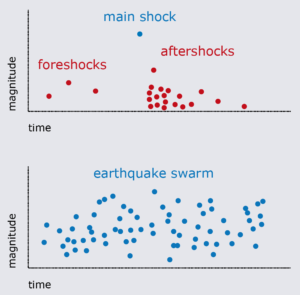In News
Earthquake swarms are sequences of many earthquakes that occur in a relatively short period without a specific main shock. In the course of a swarm, thousands of small and intermediate magnitude earthquakes can occur within some months.
Features of Earthquake Swarms
- Seismic activities can be classified into either a major quake followed by aftershocks or an earthquake swarm. In general, within major earthquakes a maximum-scale quake is followed by a number of minor aftershocks.
- The swarm earthquake is a series of the quakes of a similar scale to the mainshock. The pace of subsidence in such earthquakes occurring is gradual relative to aftershocks in normal earthquakes, and the seismic activities are protracted.
- The AD 2000 Izu islands earthquake that struck the northern Izu islands showed one of the most energetic swarms ever recorded.
- Dominant hypotheses that explain the occurrence of the swarm include the immediate influence of magma and groundwater (ex. intrusion to the fault), peculiar inhomogeneity of crustal structure and so on.
- Although the mechanism of each earthquake is the same as that of a normal earthquake, an extraordinarily high stress generated for a relatively short period rapidly elevates the rate of earthquake occurrence, resulting in distinctive seismological behaviour.
- The thousands of hypocentres of each swarm do not build a diffuse cloud, but instead form planar, fault-like structures.
- Even if the source of the swarms is most likely connected with ascending fluids, the distribution of the hypocentres seems to be located at zones of pre-existing weakness, which are most probably faults.
- They occur over an extended period without a clear sequence of foreshocks, main quakes and aftershocks and in regions with complex contiguous fracture systems.

















